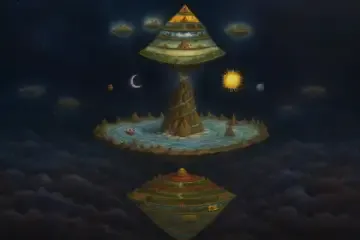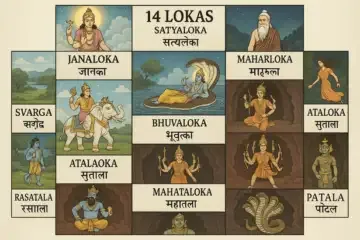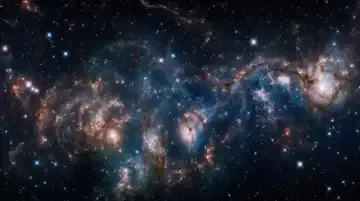This is beautifully explained in the concept of the 14 Lokas (worlds or realms). Far from being fantasy, the Lokas represent dimensions of consciousness, places where souls experience the results of their karma and continue their eternal journey. Understanding these realms gives us not only a glimpse into Hindu cosmology but also profound insight into the human condition.
What Are the 14 Lokas?

14 Lokas in Hinduism
The Sanskrit word "Loka" translates to world, realm, or plane of existence. In Hindu cosmology, Lokas are not merely physical places but dimensions of reality where different beings live, learn, and evolve. Hindu scriptures like the Puranas, Upanishads, and Shatapatha Brahmana describe the universe as structured into 14 Lokas, arranged vertically like layers of existence.
These 14 worlds are divided into three broad categories:

14 Lokas in Hinduism
Urdhva Lokas (Seven Higher Worlds) - Realms above Earth, associated with gods, sages, truth, and liberation. They represent higher states of consciousness, spiritual growth, and the rewards of good karma.
Bhurloka (Earth, the Middle World) - The central plane of existence, where humans live. It is considered unique because it is the only loka where karma is actively created, giving the soul a chance to rise or fall depending on actions.
Adho Lokas (Seven Lower Worlds) - Realms beneath Earth, inhabited by serpent beings (Nagas), Asuras (demons), and powerful energies. These are not eternal "hells" but planes of intense experiences, hidden wisdom, and material indulgence.
Together, these 14 Lokas form a cosmic map of existence, a multi-layered universe where every being has a place based on its karmic vibrations.
The Seven Higher Lokas (Urdhva Lokas)
Satyaloka (Brahmaloka) - The highest realm, home of Lord Brahma and supreme truth. Souls here are freed from rebirth and attain liberation (moksha).
Tapoloka - Inhabited by great sages and ascetics absorbed in meditation and penance (tapas). Represents intense spiritual discipline.
Janaloka - World of enlightened rishis and seers who preserve sacred wisdom. Symbolizes higher knowledge and contemplation.
Maharloka - A transition realm, where sages dwell during cosmic dissolution. It bridges the mortal and immortal worlds.
Svarloka (Svarga) - Popularly known as "heaven," ruled by Indra. Beings here enjoy pleasures, music, and joy as rewards for good karma.
Bhuvarloka - The realm of demi-gods, spirits, and celestial beings. It is also identified with the space between Earth and the sun.
Bhurloka (Earth) - Our physical world, where humans live. Considered the most important loka because here karma is actively performed, deciding the soul's future journey.
The Seven Lower Lokas (Adho Lokas)
Atala - A realm of pleasure and illusion, ruled by Bala, son of the demon architect Maya.
Vitala - Associated with fierce energies and Lord Shiva in his Bhairava form.
Sutala - The blessed kingdom of the demon king Bali, who was granted rulership here by Vishnu after the Vamana avatar.
Talatala - Ruled by Maya, master architect of demons, full of mystic knowledge and power.
Mahatala - Inhabited by serpent beings (Nagas), representing hidden wisdom and subconscious forces.
Rasatala - Home of mighty Asuras, symbolizing primal instincts and material power.
Patala - The lowest loka, often described as beautiful and wealthy, ruled by serpent kings (Nagas). Despite being "below," it is rich with splendor and energy.
What Do They Represent?
14 Lokas in Hinduism
The 14 Lokas are not just physical places; they symbolize different states of being and consciousness. For example: Satyaloka (the highest realm) represents truth, liberation, and the ultimate freedom from rebirth. Svarga (heaven) represents temporary joy, rewards, and pleasures earned through good deeds. And Patala (the lowest world) represents hidden wisdom, desires, and the mysterious depths of existence. In essence, the Lokas are mirrors of human experiences, from the noblest truths to the most primal instincts.
What Do They Mean for Humans?

14 Lokas in Hinduism
For us, the 14 Lokas are not just mythology, they are a guide to life's journey: Spiritual Roadmap: They remind us that life extends beyond this one world. Our actions, intentions, and karma shape where our soul travels, upward toward wisdom or downward into cycles of desire. Balance of Karma: Each loka reflects the principle that nothing is wasted. Good deeds elevate us to higher realms; selfishness or harmful actions pull us toward lower realms. Inner Symbolism: The Lokas can also be understood as states of the human mind. When we act with compassion, we are in our "Satyaloka." When we give in to anger, greed, or illusion, we slip into "Patala."
Hope and Renewal: Even the lower worlds are not eternal punishment. Hinduism teaches that every soul has the potential to rise again through wisdom, devotion, and righteous action.
The 14 Lokas of Hindu cosmology offer a vision of the universe that is at once vast, interconnected, and deeply human. They remind us that existence is layered, that our journey does not end with death, and that every choice we make carries cosmic significance. Ultimately, the Lokas inspire us to strive for higher realms, not by rejecting life, but by living it with truth, compassion, and awareness. In every act of kindness, we rise. In every step toward wisdom, we ascend. The 14 Lokas are not just cosmic maps of the universe, they are maps of the human soul.
Unlock insightful tips and inspiration on personal growth, productivity, and well-being. Stay motivated and updated with the latest at My Life XP

 14 Lokas in Hinduism
The Sanskrit word "Loka" translates to world, realm, or plane of existence. In Hindu cosmology, Lokas are not merely physical places but dimensions of reality where different beings live, learn, and evolve. Hindu scriptures like the Puranas, Upanishads, and Shatapatha Brahmana describe the universe as structured into 14 Lokas, arranged vertically like layers of existence.These 14 worlds are divided into three broad categories:
14 Lokas in Hinduism
The Sanskrit word "Loka" translates to world, realm, or plane of existence. In Hindu cosmology, Lokas are not merely physical places but dimensions of reality where different beings live, learn, and evolve. Hindu scriptures like the Puranas, Upanishads, and Shatapatha Brahmana describe the universe as structured into 14 Lokas, arranged vertically like layers of existence.These 14 worlds are divided into three broad categories:
 14 Lokas in Hinduism
Urdhva Lokas (Seven Higher Worlds) - Realms above Earth, associated with gods, sages, truth, and liberation. They represent higher states of consciousness, spiritual growth, and the rewards of good karma.
Bhurloka (Earth, the Middle World) - The central plane of existence, where humans live. It is considered unique because it is the only loka where karma is actively created, giving the soul a chance to rise or fall depending on actions.
Adho Lokas (Seven Lower Worlds) - Realms beneath Earth, inhabited by serpent beings (Nagas), Asuras (demons), and powerful energies. These are not eternal "hells" but planes of intense experiences, hidden wisdom, and material indulgence.
Together, these 14 Lokas form a cosmic map of existence, a multi-layered universe where every being has a place based on its karmic vibrations.
The Seven Higher Lokas (Urdhva Lokas)
Satyaloka (Brahmaloka) - The highest realm, home of Lord Brahma and supreme truth. Souls here are freed from rebirth and attain liberation (moksha).
Tapoloka - Inhabited by great sages and ascetics absorbed in meditation and penance (tapas). Represents intense spiritual discipline.
Janaloka - World of enlightened rishis and seers who preserve sacred wisdom. Symbolizes higher knowledge and contemplation.
Maharloka - A transition realm, where sages dwell during cosmic dissolution. It bridges the mortal and immortal worlds.
Svarloka (Svarga) - Popularly known as "heaven," ruled by Indra. Beings here enjoy pleasures, music, and joy as rewards for good karma.
Bhuvarloka - The realm of demi-gods, spirits, and celestial beings. It is also identified with the space between Earth and the sun.
Bhurloka (Earth) - Our physical world, where humans live. Considered the most important loka because here karma is actively performed, deciding the soul's future journey.
The Seven Lower Lokas (Adho Lokas)
Atala - A realm of pleasure and illusion, ruled by Bala, son of the demon architect Maya.
Vitala - Associated with fierce energies and Lord Shiva in his Bhairava form.
Sutala - The blessed kingdom of the demon king Bali, who was granted rulership here by Vishnu after the Vamana avatar.
Talatala - Ruled by Maya, master architect of demons, full of mystic knowledge and power.
Mahatala - Inhabited by serpent beings (Nagas), representing hidden wisdom and subconscious forces.
Rasatala - Home of mighty Asuras, symbolizing primal instincts and material power.
Patala - The lowest loka, often described as beautiful and wealthy, ruled by serpent kings (Nagas). Despite being "below," it is rich with splendor and energy.What Do They Represent?
14 Lokas in Hinduism
The 14 Lokas are not just physical places; they symbolize different states of being and consciousness. For example: Satyaloka (the highest realm) represents truth, liberation, and the ultimate freedom from rebirth. Svarga (heaven) represents temporary joy, rewards, and pleasures earned through good deeds. And Patala (the lowest world) represents hidden wisdom, desires, and the mysterious depths of existence. In essence, the Lokas are mirrors of human experiences, from the noblest truths to the most primal instincts.What Do They Mean for Humans?
14 Lokas in Hinduism
Urdhva Lokas (Seven Higher Worlds) - Realms above Earth, associated with gods, sages, truth, and liberation. They represent higher states of consciousness, spiritual growth, and the rewards of good karma.
Bhurloka (Earth, the Middle World) - The central plane of existence, where humans live. It is considered unique because it is the only loka where karma is actively created, giving the soul a chance to rise or fall depending on actions.
Adho Lokas (Seven Lower Worlds) - Realms beneath Earth, inhabited by serpent beings (Nagas), Asuras (demons), and powerful energies. These are not eternal "hells" but planes of intense experiences, hidden wisdom, and material indulgence.
Together, these 14 Lokas form a cosmic map of existence, a multi-layered universe where every being has a place based on its karmic vibrations.
The Seven Higher Lokas (Urdhva Lokas)
Satyaloka (Brahmaloka) - The highest realm, home of Lord Brahma and supreme truth. Souls here are freed from rebirth and attain liberation (moksha).
Tapoloka - Inhabited by great sages and ascetics absorbed in meditation and penance (tapas). Represents intense spiritual discipline.
Janaloka - World of enlightened rishis and seers who preserve sacred wisdom. Symbolizes higher knowledge and contemplation.
Maharloka - A transition realm, where sages dwell during cosmic dissolution. It bridges the mortal and immortal worlds.
Svarloka (Svarga) - Popularly known as "heaven," ruled by Indra. Beings here enjoy pleasures, music, and joy as rewards for good karma.
Bhuvarloka - The realm of demi-gods, spirits, and celestial beings. It is also identified with the space between Earth and the sun.
Bhurloka (Earth) - Our physical world, where humans live. Considered the most important loka because here karma is actively performed, deciding the soul's future journey.
The Seven Lower Lokas (Adho Lokas)
Atala - A realm of pleasure and illusion, ruled by Bala, son of the demon architect Maya.
Vitala - Associated with fierce energies and Lord Shiva in his Bhairava form.
Sutala - The blessed kingdom of the demon king Bali, who was granted rulership here by Vishnu after the Vamana avatar.
Talatala - Ruled by Maya, master architect of demons, full of mystic knowledge and power.
Mahatala - Inhabited by serpent beings (Nagas), representing hidden wisdom and subconscious forces.
Rasatala - Home of mighty Asuras, symbolizing primal instincts and material power.
Patala - The lowest loka, often described as beautiful and wealthy, ruled by serpent kings (Nagas). Despite being "below," it is rich with splendor and energy.What Do They Represent?
14 Lokas in Hinduism
The 14 Lokas are not just physical places; they symbolize different states of being and consciousness. For example: Satyaloka (the highest realm) represents truth, liberation, and the ultimate freedom from rebirth. Svarga (heaven) represents temporary joy, rewards, and pleasures earned through good deeds. And Patala (the lowest world) represents hidden wisdom, desires, and the mysterious depths of existence. In essence, the Lokas are mirrors of human experiences, from the noblest truths to the most primal instincts.What Do They Mean for Humans?
 14 Lokas in Hinduism
For us, the 14 Lokas are not just mythology, they are a guide to life's journey: Spiritual Roadmap: They remind us that life extends beyond this one world. Our actions, intentions, and karma shape where our soul travels, upward toward wisdom or downward into cycles of desire. Balance of Karma: Each loka reflects the principle that nothing is wasted. Good deeds elevate us to higher realms; selfishness or harmful actions pull us toward lower realms. Inner Symbolism: The Lokas can also be understood as states of the human mind. When we act with compassion, we are in our "Satyaloka." When we give in to anger, greed, or illusion, we slip into "Patala."
Hope and Renewal: Even the lower worlds are not eternal punishment. Hinduism teaches that every soul has the potential to rise again through wisdom, devotion, and righteous action.
The 14 Lokas of Hindu cosmology offer a vision of the universe that is at once vast, interconnected, and deeply human. They remind us that existence is layered, that our journey does not end with death, and that every choice we make carries cosmic significance. Ultimately, the Lokas inspire us to strive for higher realms, not by rejecting life, but by living it with truth, compassion, and awareness. In every act of kindness, we rise. In every step toward wisdom, we ascend. The 14 Lokas are not just cosmic maps of the universe, they are maps of the human soul.
Unlock insightful tips and inspiration on personal growth, productivity, and well-being. Stay motivated and updated with the latest at My Life XP
14 Lokas in Hinduism
For us, the 14 Lokas are not just mythology, they are a guide to life's journey: Spiritual Roadmap: They remind us that life extends beyond this one world. Our actions, intentions, and karma shape where our soul travels, upward toward wisdom or downward into cycles of desire. Balance of Karma: Each loka reflects the principle that nothing is wasted. Good deeds elevate us to higher realms; selfishness or harmful actions pull us toward lower realms. Inner Symbolism: The Lokas can also be understood as states of the human mind. When we act with compassion, we are in our "Satyaloka." When we give in to anger, greed, or illusion, we slip into "Patala."
Hope and Renewal: Even the lower worlds are not eternal punishment. Hinduism teaches that every soul has the potential to rise again through wisdom, devotion, and righteous action.
The 14 Lokas of Hindu cosmology offer a vision of the universe that is at once vast, interconnected, and deeply human. They remind us that existence is layered, that our journey does not end with death, and that every choice we make carries cosmic significance. Ultimately, the Lokas inspire us to strive for higher realms, not by rejecting life, but by living it with truth, compassion, and awareness. In every act of kindness, we rise. In every step toward wisdom, we ascend. The 14 Lokas are not just cosmic maps of the universe, they are maps of the human soul.
Unlock insightful tips and inspiration on personal growth, productivity, and well-being. Stay motivated and updated with the latest at My Life XP